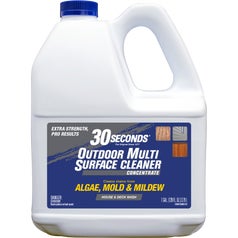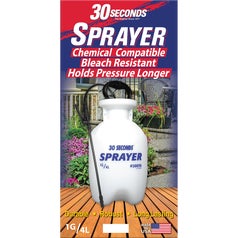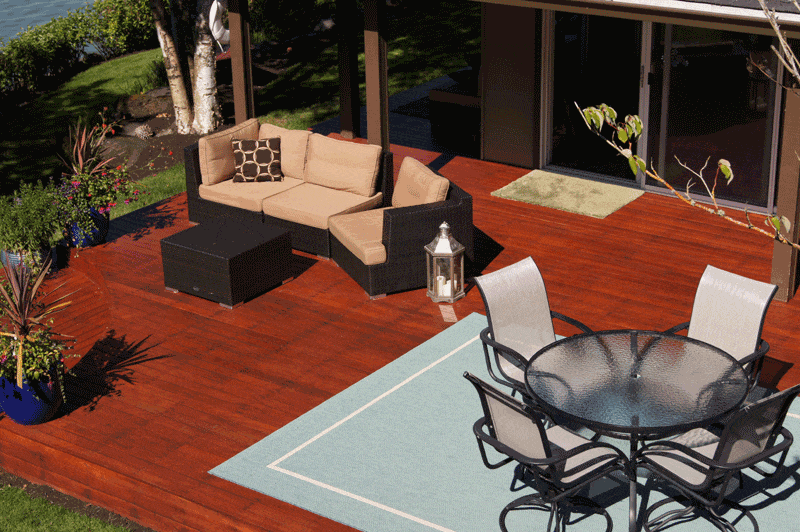Dirty deck? Clean it up!
With so much information out there about deck upkeep, it can get confusing trying to find the right way to maintain your wood deck.
- Is pressure washing dangerous?
- What is soft washing?
- What type of cleaner should you use and why?
- Does it make a difference if it's composite or natural wood?
It's important to take the time to make sure you properly care for your wood deck to maintain its beauty and longevity.
Let’s start with the basics. When it comes to wood decks, not all materials are created equal. Each has its own pros and cons. While there are several reasons for choosing each, let’s focus on features relative to cleaning.
Natural Wood Deck
From Southern Pine to Western Red Cedar and everything inbetween, natural wood decks come in a variety of options. While longevity and color changes from one type to the next, they have the same basic principles in terms of cleaning. Tight-grained natural woods usually are “water resistant” to “water tight,” but they do have a porous surface that will eventually absorb water and allow a foothold for algae, mold and mildew growth. Without proper cleaning and maintenance, they can and do eventually rot away. They're also the softest of the wood deck options, leaving them more susceptible to wear and tear. The naturally occurring tannins and oils present in the wood need to be protected and preserved if you want your deck to maintain its like new appearance for years to come. It's recommended to clean a natural wood deck at least once a year for proper maintenance.
Pressure Treated Wood
There's no doubt that pressure treated wood has become a popular choice. From pine to local coniferous trees, pressure treated wood is economical and lasts longer than natural wood, making it a common deck material across the country.
However, without proper cleaning and maintenance, this option is prone to warping and can quickly become saturated and heavy with continued exposure to moisture. Pressure Treated Wood is more durable than natural wood and less susceptible to rot. However, algae, mold and mildew growth are just as common on these porous boards. Like a natural wood deck, pressure treated wood decks also require a yearly clean for optimum results.
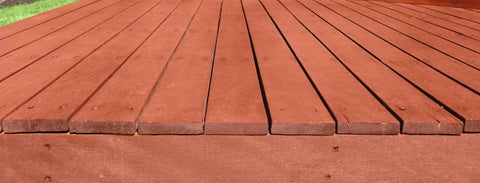

Composite Decking
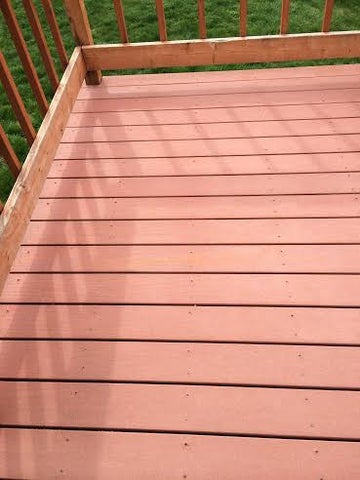

Composite decking is sometimes called wood-plastic composite, or WPC. While usually containing some amount of wood, composite decking is a hardy choice that lasts for decades against frequent use and rough elements. Often made from recycled fibers sometimes referred to as wood flour, plastics or cements, this option may not feel as nice on the bare foot, but it is hardier and lasts longer with proper maintenance.
The process of creating these boards results in even color shift, little to no warping and a smoother, slightly less porous surface. Composite materials do not absorb water and are durable to tough wear and tear. Ironically, though a sturdier material, manufacturers often suggest a two- to three- times a year cleaning.
It is important to note that while newer composite boards are often produced with a mildewcide or some other fungal growth prohibitive, older boards often were not. This was added to newer composites after it was realized that the algae, mold and mildew would feed on the wood fibers.
Synthetic Lumber
While made to look like wooden boards, synthetic lumber decks are typically made from vinyl, PVC (polyvinyl chloride) or polystyrene. These ingredients are byproducts of both oil and natural gas production, and therefore can experience some price shift with the volatile oil markets. This durable, affordable option saves time and money. Color and quality vary from one manufacturer to the next, but this option is universally long lasting and easy to clean and maintain.
Synthetic Lumber
While made to look like wooden boards, synthetic lumber decks are typically made from vinyl, PVC (polyvinyl chloride) or polystyrene. These ingredients are byproducts of both oil and natural gas production, and therefore can experience some price shift with the volatile oil markets. This durable, affordable option saves time and money. Color and quality vary from one manufacturer to the next, but this option is universally long lasting and easy to clean and maintain.
Cleaning a Brand New Deck


When should you first clean a brand new deck? The quick answer: Wood decks — including natural, pressure treated or composite decking — typically should be cleaned within 3-6 months after installation, with the obvious exception of spot cleaning spills and messes (except for cedar, but we'll get to the later).
If you're looking to stain a new deck, regardless of material, it's suggested to clean it first. Again, wait 3-6 months prior to cleaning and staining. A new deck typically has mill scale, which is the grain of the wood that has been crushed flat as the boards are milled. Cleaning a newer deck prior to staining removes the mill scale and any particles that have settled, all while creating a slightly more porous surface that will let the stain soak in and result in true to color, even results.
A Note on Cleaning Cedar


One little known difference with natural wood care is with cedar. It is recommended to clean new, smooth cedar boards right away, unlike other types of natural wood decks.
Cedar is a very popular choice for decks as well as a vast array of other building projects. This beautiful, durable wood has a couple of drawbacks, one of which is how to properly clean it.
When cleaning a cedar deck with any sort of cleaner, it's possible to end up with a white film called "wood fuzzies" or furring. Furring can occur any time cedar is cleaned, but is most seen in two scenarios: New cedar (remember the mill scale mentioned previously) or with heavily oxidized wood. Heavily oxidized cedar is characterized by a dull, gray appearance. In either situation, its these damaged cells that are lifting up from the boards.
Don't panic, this is normal and will erode away on its own in time. However, if you want to have a bright beautiful deck or want to stain after cleaning, then this furring may be frustrating.
There are a few things to be done to prevent furring in the first place:
- Use the suggested concentration only with the cleaners. Stronger isn't always better and can damage and lift more fuzz than proper concentrations.
- Rinse, Rinse, Rinse. Cleaners left behind on the wood surface not only mask the results of the cleaning, but also continue to react with the cedar causing more fuzzing.
- If brushing in the surface during cleaning, avoid scrubbing and brushes that have bristles that are too hard. Lightly brush to move around the cleaner with bristles no harder than a normal outdoor broom.
- Stain after cleaning but while the wood is still wet.
- Consider using a wood brightener immediately after cleaning if you don't plan to stain.
- Consider using 30 SECONDS Spray & Walk Away. Since this is a treatment and not a cleaner, it's less likely to raise wood fuzzies.
If it's too late and you're looking to remove wood furring, follow these steps:
- Leave it alone. It will wear away over time.
- Use light sanding or buffing once the deck is dry. Do your research. Aggressive sanding will only make the fuzzies worse or possibly harm your deck. Many people have success using sanding buffing pads or even a stiff bristled broom.
- Do NOT try to use more cleaner to remove wood fuzzies. That will only result in further fraying.
Next, let’s discuss what it is that you want to clean off your deck. When categorizing messes or stains, they're typically broken into two categories: organic or inorganic. The types of cleaners used for these are different and need to be approached differently.
Cleaning Painted Wood
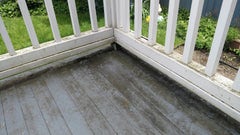

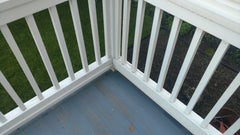

Regardless of the type of deck material, cleaning a deck that's been painted can really brighten and improve the look of your outdoor living space. When cleaning a painted deck, it's always a good idea to test out your process in a small, out-of-the-way area to make sure you get the results you want. Several situations can occur that may result in paint lifting off of the deck. If planning to repaint, this may not be an issue.
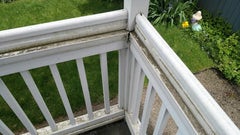

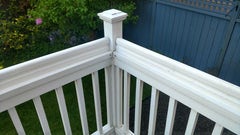

If you are planning to clean a painted deck and not repaint afterwards, there are a couple topics to consider:
- While just about all outdoor paint is colorfast and made to take on sun, rain and cleaners, not all paints have been tested against all cleaners. It's extremely rare to see color shift in paint as a result of cleaning, but when it occurs, it's typically with red or purple paints.
- Paint could "lift" if the dirt and grime is between the wood and the paint, whether pressure washing or simply using an outdoor cleaner. Even with soft pressure washing, blasted water can end up under the paint and peel it off the wood.
- A good cleaner does its job and cleans deep into the algae, mold, mildew, dirt and grime. When rinsed away, the paint that was no longer on the wood can lift away. This can wreak havoc if the paint was originally applied to a dirty surface.
Bottom line, if it's your first time cleaning painted wood, it's always a good idea to test it out first.
Organic, Naturally Occurring Stains
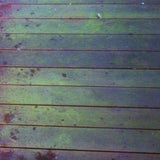

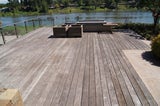

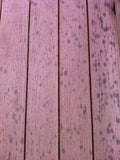

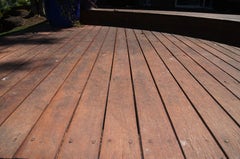

The most common issues come from dirt, grime algae, mold and mildew growth. This can result in a slick surface that is as dangerous as it is disgusting. These organically occurring stains are typical to the outdoors in general, but tend to be more prevalent in wet, humid climates.
The Pacific Northwest experiences rainfall averages of 40 inches and some 160 days of rain. However, the wettest parts of the country are most commonly found in the Southeast region, especially Florida. In fact, did you know the top nine rainiest cities are all located in the south? Slimy green and slippery black algae, mold and mildew occur anywhere wet, humid conditions exist.
Organic stains can also occur from wildlife. People are often looking for ways to remove messes from bird and even spider droppings or cobwebs. These can become baked-on messes and are as gross as they are unsightly.
Grease, Oil and Inorganic Messes






You spilled what on the deck?! Sometimes stains on the deck are not just related to the weather. A lot of life happens on our decks, and accidents are to be expected. Greasy stains from grilling, oil stains from bike or lawnmower maintenance, spills of all types and more can mar the beauty of your deck. The deck is the living room of the summer, and it can really take a beating. These cleaning conundrums can raise different challenges from organic stains. You'll most likely need to take a different approach to cleaning.
Sweeping/Hosing
Some people live in drier regions where all they need to do is break out a broom or garden hose to clean their deck. A quick sweep, no dustpan needed, and their deck is right back to clean usability. While a quick and easy treatment can help to prolong the life of these decks, little more than basic cleaning and re-staining per manufacturer’s instruction is ever needed.
Pressure Washing
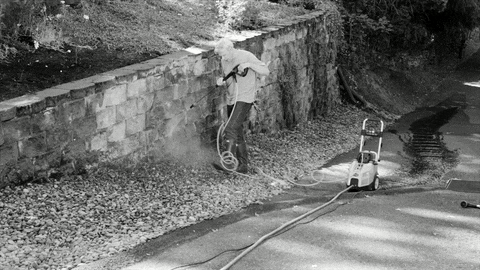

Pressure washers are not cheap. But when looking for a fast, relatively instant result, some people still turn to the pressure washer. But there are dangers of pressure washing wooden decks. Pressure washing can damage wood, especially softer woods such as cedar. Done incorrectly, a pressure washer can take out landscaping, a window or a chunk of your deck quick. Despite what the name might imply, even pressure treated wood doesn’t stand up well to pressure washing. While composite or synthetic lumber can better withstand the abuse, the bottom line is pressure washing, especially over 1500 PSI (pounds per square inch), can damage your deck.
Pressure washing can also wreak havoc with the spores or the “seeds” that algae, mold and mildew grow from. While you can’t see it, these microorganisms can get forced into the nooks and crannies of wood and composite decking alike. Now they have a moist, protective little hideout to put down roots and begin growing anew. Synthetic lumber tends to be a less porous surface so the spores have a slightly better chance of getting blasted away, but some spores will always be left behind. Regrowth begins to occur almost immediately and begins to become visible a mere few weeks after all your hard work.
Achieving an even, clean finish with pressure washing can also prove quite challenging. Streaking, striping and an overall uneven appearance can often be the result of hurried pressure washing. Without proper tools and a “sweeping” and “feathering” technique, your hard work could result in a blotchy, uneven clean. Sweeping is achieved by keeping your hand in constant motion as the pressure washer is spraying while moving with the grain of the wood and working to maintain a constant distance of the nozzle from the surface of the deck for even pressure. Feathering is similar, with multiple short passes starting and stopping while overlapping from the previous pass. Feathering is a slower technique, but superior for consistent results when done properly.
Composite decking can handle a higher PSI than natural or pressure-treated wooden deck. While this varies from manufacturer, the general rule of thumb is no more than 3000 PSI, which would easily gouge a natural wood deck. Again the proper use of “sweeping” and “feathering” is essential for an even clean.
Finally, between the power and water wasted, pressure washing is not a very “green” solution. With more of us concerned about our carbon footprint, global warming and caring for our environment, pressure washing proves to be a less than ideal choice for cleaning a wooden deck.
Between the cost, lackluster results and risk of damage to the deck, it's no wonder more people are looking for a safer more effective alternative to pressure washing.
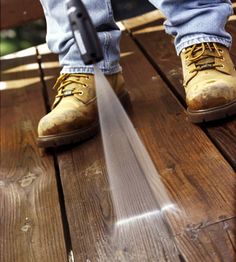

Soft Washing
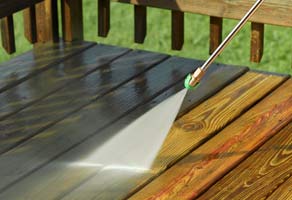

Cleaning the deck with a pressure washer using a lower PSI, usually around 1200-1500 PSI, and sometimes as low as 800 PSI, has started to replace traditional pressure washing. Even at 1500 PSI you still risk tearing up soft wood or result in lap marks on composite decks with an inconsistent clean. While this is less likely to dig deep grooves on a wooden surface as regular pressure washing, it still has some drawbacks. Again, you’ll either need to purchase or rent a unit, which can get costly quickly. Soft washing also still does nothing to remove spores or prevent regrowth, and still requires “sweeping” and “feathering” to get an even finish. Couple that with the need for power, be it gas or electric, and the excessive amount of water used, this still seems a poor choice for fast, instant results.
Soft washing also uses just water unless an additive is used. When using just water, nothing is done for the treatment or removal of the spores. Once again, pressure washing, even soft pressure washing, seems to end up as a lot of work and expense for subpar results.
That being said, many people do still choose to pressure wash their decks. Experienced pressure washer users will often say that the above-mentioned issues stem from people inaccurately using their equipment. So why would someone still choose to pressure wash, be it soft wash or traditional? One reason is that the pressurized water removes a wide variety of stains blasting oily grease or slippery algae with the same level of effectiveness. Some may also feel this is an effective way to strip away old paint, varnish, or stain to prep a surface for repainting or staining. Also, if you find yourself needing to clean everything from your car tires to your roof, a pressure washer may feel like a 1 size fits all solution. Just remember, not all pressure washers are created equal.
When cleaning a wood deck with a soft wash, the general consensus is to use a low PSI, again 1200-1500 PSI, and a 45 degree angle fan. Keep your hand sweeping continuously while the water is flowing in the “sweeping” or “feathering” technique for a uniform clean.
Outdoor Cleaners
A quick internet search will result in more outdoor cleaners and Do It Yourself mixes than you could try in a lifetime. The bottom line is that with enough elbow grease, pretty much all cleaners work. Ask someone who has used a mud mask to improve the quality of their skin, for example, and you’ll see what we mean.
The efforts from a side-by-side comparison would be a massive undertaking. Luckily for us, we have loyal customers who have done testing of their very own, and were kind enough to share their results with us.
We have a wonderful picture provided by a customer comparing our Outdoor Cleaner to using traditional bleach.
Another customer provided us with these pictures comparing your Outdoor Cleaner to a competitor’s product on his cedar shake siding.
So let’s talk about what people are looking for in a cleaner, and why 30 SECONDS is the Original and still the best since 1977!
30 SECONDS Outdoor Cleaner is a fast, effective way to clean stains from Algae, Mold and Mildew off your deck with minimal time, effort and money. Specially formulated to penetrate deep into nooks and crannies for a truly deeper clean that you can see, and a lasting clean that holds up for months without any additional effort. Here is a great video explaining how to use 30 SECONDS Outdoor Cleaner. Fast, safe, and effective, “It’s clean when YOU want it clean!”
Outdoor Treatments
Another option for even faster, easier application, and less water usage, is an over-time treatment to kill Lichen, Moss, Mildew and Algae. While these treatments do not instantly show results, the fact that you can just Spray & Walk Away makes treatments a very popular choice.
Treatments are often a very affordable option as well. Our 1 gallon of Spray & Walk Away makes 6 gallons of product. That covers a lot area very quickly. To find out more about 30 SECOND Spray & Walk Away, click here. The biggest drawback to an over-time treatment is that the results are not instant. However if you’re looking to get more use out of your purchase and don’t have big party on the deck this weekend, then an outdoor treatment may be right for you.
Degreasers
Perhaps what you’re looking to clean off isn’t Algae, Mold, and Mildew. If you’re looking to remove greasy, oily stains from you deck, perhaps from previous barbecues or that time you worked on the lawnmower and spilled some oil, then you need a degreaser. The 30 SECONDS Degreaser is a super concentrate formula made to clean everything from the kitchen sink to the garage floor. It's non-corrosive and water based, so it's safe on your deck and around your yard and family. Fats, oils, greasy, and soapy scum is no match for a good degreaser, and ours is a safe, super concentrate formula perfect for these jobs.
Proper deck cleaning is important to maintain a safe, healthy home. Whether you’re looking to clean your deck as part of basic maintenance, or needing to create a clean surface to paint or stain, 30 SECONDS Cleaners has the right product for you. For more information about our products contact us directly.



















